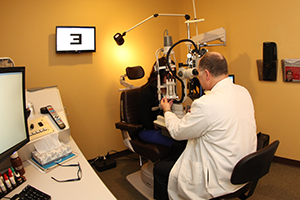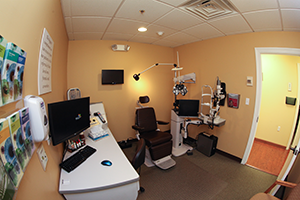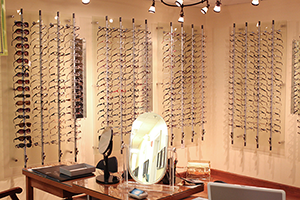Services in Paterson
Comprehensive Eye Exams
 Regular eye exams are an invaluable tool in maintaining healthy eyes by detecting and preventing disease. Some diseases develop slowly without causing pain or vision loss until it is too late. Early detection of these problems can reduce the risk of further harm and allow for a better treatment options. A comprehensive eye exam generally includes an evaluation of your vision and refractive error, or need for eyeglasses, measurement of the eye pressure which screens for glaucoma and a careful examination of the outer and inner structures of the eye, often done after dilating the pupils. The dilation may cause some blurring of your vision, especially up close, in addition to sensitivity to light for several hours. Other high-tech equipment is also used to help detect eye disease during this type of exam.
Regular eye exams are an invaluable tool in maintaining healthy eyes by detecting and preventing disease. Some diseases develop slowly without causing pain or vision loss until it is too late. Early detection of these problems can reduce the risk of further harm and allow for a better treatment options. A comprehensive eye exam generally includes an evaluation of your vision and refractive error, or need for eyeglasses, measurement of the eye pressure which screens for glaucoma and a careful examination of the outer and inner structures of the eye, often done after dilating the pupils. The dilation may cause some blurring of your vision, especially up close, in addition to sensitivity to light for several hours. Other high-tech equipment is also used to help detect eye disease during this type of exam.
Cataract Surgery
A cataract is a clouding of the natural lens of the eye. As the cataracts progress, eyeglass prescriptions may initially change to help improve vision; eventually the cloudiness becomes dense enough to cause blurry vision that changing glasses cannot clear up. Cataract surgery involves the removal of the cloudy lens and the implantation of an artificial lens. The current technique for cataract surgery is called phacoemulsification (ultrasound) through a small incision. Since a self-sealing small incision is used, it usually does not require suture closure, thus the term "no stitch cataract surgery." The entire procedure, performed under local anesthesia is usually completed in 10-15 minutes. After surgery with traditional lens implants, most patients experience very good distance vision. However, most people receiving these standard lenses still require reading glasses or bifocals to have a full range of vision.
Refractive Cataract Surgery
Patients with significant astigmatism will usually need glasses to see clearly for both distance and near after cataract surgery. New lens implants are available that can correct the astigmatism allowing for clearer distance vision and less dependence on eyeglasses after surgery. For smaller amounts of astigmatism, surgical technique or limbal relaxing incisions (LRIs) may be performed to lessen the astigmatism by placement of thin incisions in the peripheral cornea.
In addition, multifocal lens implants, or lenses that correct vision for both distance and near are available to allow patients freedom from eyeglasses approximately 80% of the time. Not everyone is a candidate for these lenses.
These premium lens implants are generally not covered by health insurance.
Glaucoma Care

Glaucoma, the leading cause of blindness and visual impairment in the United States, is an eye disease that is nicknamed the silent thief of sight. Generally, glaucoma begins without symptoms and can silently cause permanent damage to the optic nerve. Early diagnosis is the key since early treatment can prevent loss of vision.
Glaucoma is well known to be more common and more severe in the African-American and Hispanic communities. In addition, anyone with a family history of glaucoma or any one of several other findings has an increased risk of this potentially blinding disease. Most people who are diagnosed early enough, begin treatment and follow up as recommended do very well and loss of vision is not common.
Because of our patient population we deal with a very large number of glaucoma patients and those who are at risk for glaucoma. Our office is equipped with the latest technology to help determine the onset of glaucoma at the earliest possible time. This includes the latest visual field techniques, OCT, including the latest Ganglion Cell Complex (GCC) measurement technology, central corneal thickness measurements and stereo/3-D nerve photos.Updating our medical knowledge on a regular basis regarding glaucoma management is a high priority.
We now have an in-office SLT laser which is being chosen more and more as the first line treatment for newly diagnosed glaucoma. This treatment is well tolerated, quick and effective. It can help avoid the problems associated with eye drops which include inconvenience, cost, potential side effects and a lifetime commitment.
Diabetic Eye Care
In the United States, diabetes is the leading cause of blindness in people under the age of 65. While it can cause cataracts and glaucoma, diabetes can cause the devastating eye disease known as Diabetic Retinopathy. The weakening of the small blood vessels in the retina can cause leakage and bleeding and in advanced cases, scarring and even retinal detachments. These changes are painless and will not be noticed by the patient until they affect the very center of the retina where it will cause the vision to diminish.
For these reasons regular eye examinations are strongly recommended for all diabetics. Blood sugar control, of course, is critical to diminish the risk of these complications. When needed, treatment is very effective in stabilizing the eye to hopefully prevent dreaded loss of vision.
Dry Eye
The usual symptoms of dry eyes include stinging or burning, scratchiness or gritty and sandy feeling, stringy mucus, excess irritation from smoke or wind, discomfort when wearing contact lenses and even tearing.
Dry eye may be caused by decreased tear production which often happens as we age and is most common in women especially after menopause. Poor quality tears due to an abnormality of any of the three layers of the natural tears can cause symptoms of dryness.
It may also be associated with many of the autoimmune or collagen vascular diseases such as rheumatoid arthritis, lupus or Sjogrens syndrome. It may also be present in some types of thyroid disease and as side effects of some common medications.
Diagnosis of the condition is made by taking into account both the history and findings on the exam. This may include measuring the tear production or looking for signs of dryness on the surface of the eye. Treatment may include replacement of the natural tears with lubricating artificial tears or prescription drops which help to produce more and better quality natural tears. Other treatments may include methods to keep your own tears in contact with the eye for longer periods of time, adding certain supplements to your diet and avoiding certain environmental situations which can worsen the drying effects of the tears.
Laser Floater Removal / Vitreolysis
Vitreolysis is a pain free, non-invasive procedure designed to eliminate bothersome floaters. This is accomplished using a laser, through the application of light pulses, to evaporate the vitreous opacities which cause floaters resulting in a return to normal vision. The procedure is performed on an outpatient basis. Click here for more information.
Optical Services
Contact Lenses
Contact lenses correct your vision and are easy to wear. Choosing the contact lenses that are right for you depends on your vision, refraction, lifestyle and comfort. There are many types of contacts to suit almost anyone. Newer materials are now available to help those who have had trouble adjusting to contacts in the past due to dryness or irritation.
Dr. Sarah Westreich is our contact lens expert and will help you find the best contacts for your eyes, insuring good vision and a comfortable, healthy fit. This is most important to reduce the chances of contact lens related problems which in rare cases could be dangerous to the health of your eyes.
Eye Glasses
 Eyeglass lenses look simple, but can be quite complex. At Eye to Eye Optical, the full service optical shop in our office, Desiree will treat you like Family. She will advise you and educate you about the various options available and help you decide which is best for you. You can trust our team to provide you with guidance on the latest and best technology in thin lightweight lenses, multifocal designs and lens coatings. Click here for more information.
Eyeglass lenses look simple, but can be quite complex. At Eye to Eye Optical, the full service optical shop in our office, Desiree will treat you like Family. She will advise you and educate you about the various options available and help you decide which is best for you. You can trust our team to provide you with guidance on the latest and best technology in thin lightweight lenses, multifocal designs and lens coatings. Click here for more information.






